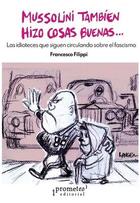A lie about the past is comforting, confirms feelings about which one would otherwise feel ashamed, and sets reassuring benchmarks, regardless of whether they are true or false.
Destroying a hoax of a historical nature, then, has two effects: the first is to correct the set of information about the past that is used to build one's own individual and collective memory; a use that we will call 'neutral', or at most, 'restorative'. The second effect, more difficult to achieve, is to destroy the certainties and presumed real data in the listener; a dangerous phenomenon, which can create a wall of incommunication. A certainty is not destroyed with impunity.
For this reason, the work of deconstructing historical falsehoods is often of little use in changing the attitude of the disseminators of this news. But it is a work that is carried out to circumscribe the scope of dissemina...read more
All book titles by this author
|
Title |
Price | ||
|---|---|---|---|
|
|
Mussolini también hizo cosas buenas Author: Francesco Filippi Publisher: Prometeo |
$414.00
15%$351.90 |
Shopping cart
Loading cart
Important notices
|
|
Recordando a André Rouillé: Su legado en la fotografía André Rouillé 1948 - 2025 |
|
|
Libros de filosofía y co. Disponibles en Librería Herder |
|
|
Revista Filosofía & Co. nº 9 Nueva revista de filosofia divulgativa y actualidad |
|
|
"Espacios de la filosofía" - Mauricio Beuchot - Novedad Herder México |
|
|
Revista Filosofía & Co. nº 8 Nueva revista de filosofia divulgativa y actualidad |
Pay safely with:


In the webshop
New
|
|
Fragmento de una historia futura 70143 $340.00 -20.00% $272.00 |
|
|
Individuo y comunidad en Spinoza 70144 $790.00 -20.00% $632.00 |
|
|
Medios calientes 70159 $400.00 -0.00% $400.00 |
|
|
Amigdalatrópolis 70157 $390.00 -0.00% $390.00 |
|
|
Detransición, baby 70158 $530.00 -0.00% $530.00 |
In the press
Promotions
|
|
Psicología de grupos 20787 $800.00 -80.00% $160.00 |
|
|
El Instante eterno 20573 $520.00 -50.00% $260.00 |
|
|
Hacerlo Explícito 20472 $3,585.00 -50.00% $1,792.50 |
|
|
Hartos de corrupción 34956 $400.00 -50.00% $200.00 |
|
|
Filosofía de la edad antigua 20411 $605.00 -50.00% $302.50 |







